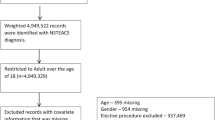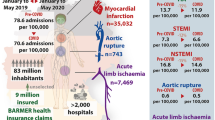Abstract
Background: There is conclusive evidence from large scale randomized clinical trials (RCTs) that several treatments administered in the acute phase of a myocardial infarction (AMI) reduce mortality. However, only a minority of patients admitted with AMI receives at the appropriate treatments.
Objectives: This study aims at (1) describe the utilization patterns for AMI; (2) determine the appropriateness of prescribing, measured as adherence to the ACC/AHA guidelines; and (3) determine which factors are associated with the administration of thrombolytic agents.
Methods: The study was a multi-center survey carried out in ten countries (nine European and one Canadian province) over a 3-month period. Data were prospectively collected by clinical pharmacists. All consecutive patients admitted to the participating hospitals during the study period with a diagnosis of suspected AMI were included in the study. Rates of use were calculated as “overall utilization” and “adjusted utilization” (e.g., accounting for eligibility).
Results: Data were available on 1976 patients from 56 participating centers. The mean age of the patients was 65 years (range 25–95, SD = 12.6) and 29.7% were women. Adjusted utilization rates were 63.7% for thrombolysis, 88% for aspirin, and 65.9% for β-adrenergic blocking agents. The most utilized thrombolytic agent was streptokinase (65.9%). The main reasons given by physicians for not administering thrombolysis was the delay from chest pain onset to admission. Patients admitted to teaching hospitals were less likely to receive aspirin than patients admitted to general hospitals (adjusted rate 90.1% vs 86%, P = 0.007), but they were more likely to undergo a primary invasive procedure (11.0% vs 2.5% P = 0.001). Multivariate analysis showed that age greater than 74 years, delay, prior myocardial infarction, and Killip scale were correlated with the non-utilization of thrombolysis.
Conclusion: Recommended treatments are still underutilized in patients with AMI. Increased utilization is required, particularly for elderly people. There is a wide variability among hospitals with different affiliations (teaching vs non teaching), demonstrating the different patterns of practice in various settings.
Similar content being viewed by others
Author information
Authors and Affiliations
Additional information
Received: 2 February 1998 / Accepted in revised form: 8 August 1998
Rights and permissions
About this article
Cite this article
Venturini, F., Romero, M. & Tognoni, G. Patterns of practice for acute myocardial infarction in a population from ten countries. E J Clin Pharmacol 54, 877–886 (1999). https://doi.org/10.1007/s002280050570
Issue Date:
DOI: https://doi.org/10.1007/s002280050570




